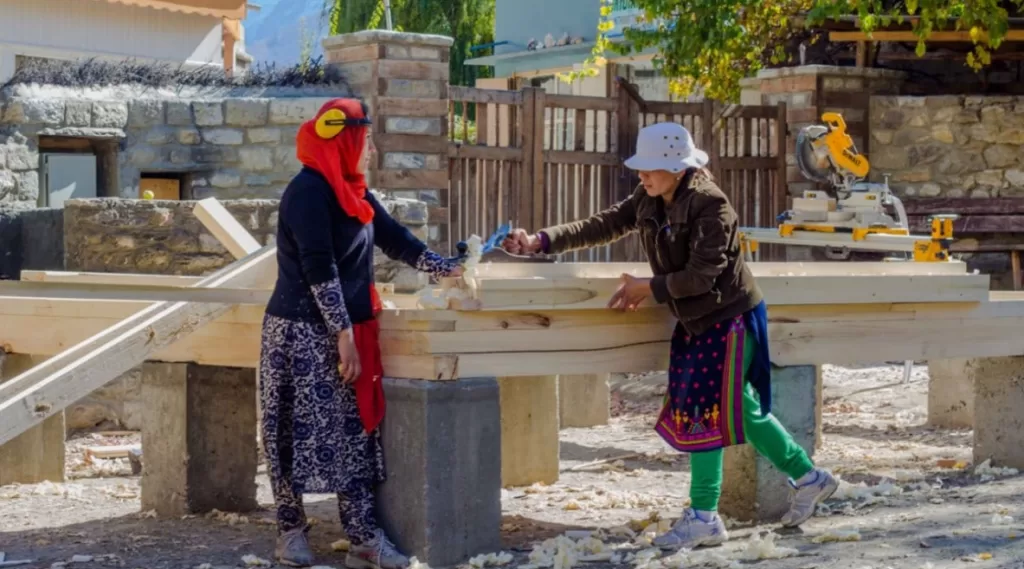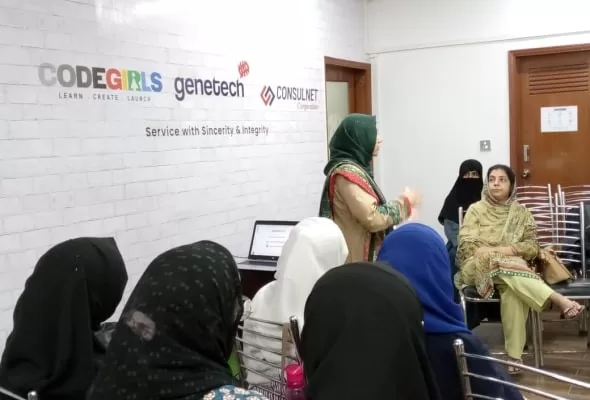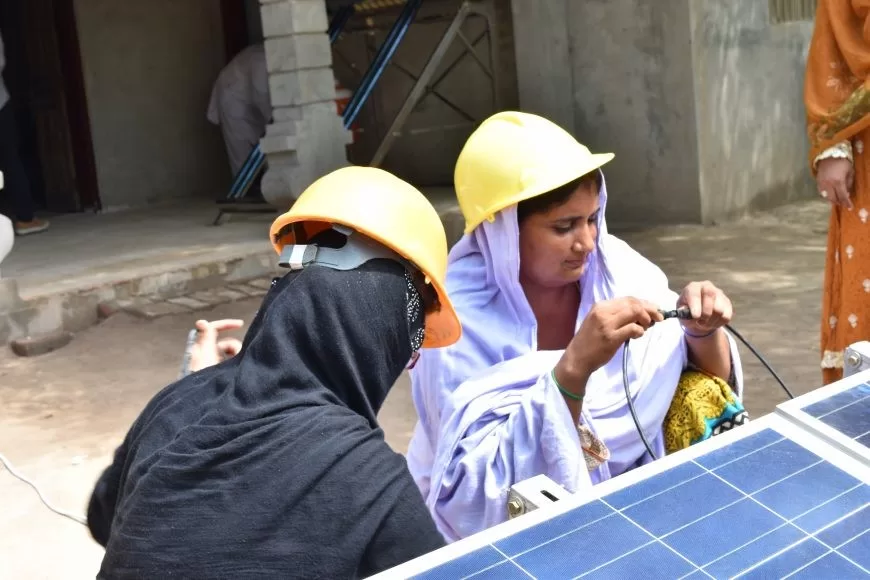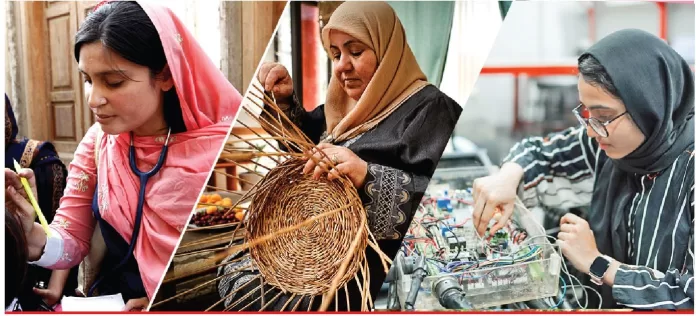Women at Work
In the world, women are winning awards in every field of life and excelling at workplaces and their achievements are surpassing their male counterparts. Women at work, whether it is blue-collar jobs or white ones, their dedication and hard work have a significant impact. A study conducted by Korn Ferry in 2016, using data from 90 countries, found that women are better than men at using soft skills crucial for effective leadership and superior business performance. The report recommended providing resources to further nurture and develop women leaders. This is an example of women’s emotional intelligence competencies.
In developing countries like Pakistan, females (almost 50% of the population) have only 22% labour force participation as females either get married without starting a career or take their role as homemakers. They will spend their lives in unpaid care work. If they enter the job market, they will be paid less than men. They face discrimination in every sector, and skill development is one of them. There is a lack of opportunities and competitive learning and working environment. Students in the technical and vocational institutes are getting the same skills, but females are employed at a lower wage rate. At the Technical and Vocational Education and Training (TVET) institutes, women are not taking all available courses, which shows limited opportunities and gender inequality at the entry-level. They are restricted to learning specific skills, such as embroidery, stitching, and beautician courses. Diversification in skills especially a focus on soft skills is a need of the time. Skills for all, focusing on women and transgender people, as these are a marginalised segment of society. The stereotype about women needs to be changed for sustainable and inclusive development. Skills should be accessible to all individuals, regardless of their gender, caste, creed, religion, and ethnicity.

Gender Wage Disparity
In Pakistan, the gender wage gap is higher (34%) than the global average of 23%, this disparity has a negative relation to economic prosperity i.e. when the gender wage inequality increases, the economic prosperity decreases, and vice versa. Many researchers have concluded that in Pakistan, the stark difference in wages is because of workers‘ efficiency depending on their education status and the productivity of labour and in a case where women work equally to men but receive less salary, this is discrimination based on gender and not the professional factors or the ability to work.
This gender pay gap hinders economic growth as per a study published by Cogent Economics & Finance If females are paid less than males for similar jobs, it results in a 35% reduction in economic growth and a 50% rise in gender wage gap. In Pakistan, if gender wage disparity is decreased by 1% then economic prosperity will significantly increase by 4.2%. this can be achieved by increasing the job quota for females, investing in their education and health focusing on the skill development of girls, making them independent and ensuring their digital and financial inclusion. Gender inequality eradication in the job sector is essential for the sustainable growth of the economy.
According to the Labour Force Survey in Pakistan (2021-22), in Pakistan, women workers contribute more than men in the agriculture sector (67.9%) but it is mostly informal and needs to be present at the national level. The farm managers distribute pre-decided tasks between genders (without women’s input in decision-making).
The pre-set farm duties for female workers are sowing, weeding, transplanting, and harvesting. Men perform machine-operational jobs such as tractors, water pumps, and irrigation systems. Females are increasingly working in manufacturing and services but achieving gender equality requires reducing the pay gap, providing access to capital and markets, investing in skills, education, and health, promoting leadership inclusion, encouraging women entrepreneurs, and enforcing anti-harassment laws. There is a need to raise awareness about emerging technologies and establish skill development centers in rural areas. In manufacturing, females are mostly in the textile, garment, leather, footwear, and food industries, while construction, chemicals, mining, and automation remain male-dominated.
To increase women’s participation in economic development, there is a need for initiatives like TVET (technical and vocational education and training) and Science, Technology, Engineering and Mathematics (STEM) related courses/education in rural and urban areas. Also, encourage the employability of females in all sectors of the economy by introducing mentorship and internship opportunities. Link industry with skill institutes to teach required skills and reduce the gap between TVETs and the Manufacturing sector. Similarly, women’s participation in the services sector is not tapped fully. There is a huge global demand for social services, including education, health, community and household services. Pakistan can do wonders in these areas as it has a huge potential with a fast-growing population.
The only issue in exporting paramedical staff and other skilled labourers is the lack of soft skills, i.e. communication (English language), teamwork, interpersonal skills, stress management, problem-solving, and critical thinking. Soft skills were not given importance in the past which resulted in a skill gap in the industry, as reported by the British Council in 2015. It was alarming to note the lack of coordination between the skills required by the industry and the skills provided by the TVET institutions in the Sindh province, the economic hub of Pakistan.
While the youth was becoming a burden because of the lack of job opportunities, the situation of female students was even worse as they were limited to joining a few courses only i.e. beautician courses, embroidery, tailoring, cooking, etc. If a female can become a pilot or an engineer, then why not a driver, plumber, or electrician? However, since then things have improved as now women are driving heavy traffic vehicles as well.
We need women leaders as they bring diversity, innovative ideas and different problem-solving methods. The promotion of women’s literacy and their involvement in the formal economy necessitates the removal of cultural and economic barriers, as well as the disruption of stereotypes related to the acquisition of technical and interpersonal abilities.

SHEFIXES By NAVTTC
In Pakistan, the National Vocational and Technical Training Commission (NAVTTC) plays a crucial role in promoting gender equality through skill development. The initiative #SheFixes for Women, led by Gulmina Bilal, chairperson of NAVTTC has successfully opened opportunities for women to learn valuable skills and make economic contributions. She noted the lack of opportunities and stereotypical roles assigned to women in Technical and Vocational Education and Training (TVETs). She says the goal of #SheFixes is to empower women by providing them with practical skills that enhance their lives and contribute to their personal and professional development. Eligible women, regardless of their roles as housewives or students, are encouraged to apply and seize this opportunity for growth. In the initial phase, it is enrolling in 9 big cities: rolled out in nine cities: Islamabad, Lahore, Quetta, Peshawar, Mirpur, Gilgit, Skardu, and Hunza. It will also open the international job market for women.
Initiatives like ‘She Fixes’ empower women by providing vocational training in fields traditionally dominated by men, such as plumbing and electrical work. This aligns with the United Nations Sustainable Development Goals, particularly those focused on gender equality, economic growth, and reducing inequalities.
The NAVTTC works with broader strategies to collect gender data and develop evidence-based policies as shown in the National Report on the Status of Women. These efforts aim to break down cultural and economic barriers, promote self-reliance and independence for women, and ensure their equal participation in the workforce. The NAVTTC’s inclusive programs furnish women from all social segments with fundamental vocational skills, enhancing their job prospects and contributing to economic growth.
Ms Kheezia, a Media Person at NAVTTC, while talking to the author showed excitement over the overwhelming responses on the launch of special skill training programs in Azad Jammu & Kashmir (AJK), Gilgit-Baltistan (GB). In AJK, 1500 seats were allocated across 25 institutes, with a strong public response as 2120 applications were received.
Similarly, GB saw high participation with 3370 applications for the 1500 allocated seats. The “SHE FIXES” program, focused on empowering women, also received significant interest with 2040 applications submitted against the available 500 seats. These figures demonstrate a positive public response to NAVTTC’s skill development initiatives, suggesting a high demand for vocational training opportunities across these regions.

TVET for Youth an Asset
Arguably one of the greatest challenges facing the TVET sector is the deeply-held belief that vocational qualifications are inferior to their academic counterparts. It is therefore important to promote the value of technical and vocational education to students, parents, teachers and employers. This can be supported by the introduction of accredited and rigorously assessed qualifications.
There are only 3,740 training institutes with a capacity of 437,000 students and 18,207 trained teachers in the formal TVET sector all over Pakistan. To cater for the 5 million youth population there is a need for at least 45,000 further training institutes and 200,000 more TVET teachers to be inducted into the system to provide skills training to youth, especially females. This also requires capacity building for the thousands of teachers at these institutes. Better remuneration would attract more qualified teachers.
In addition, continual professional development for teachers, including knowledge exchanges between industry and the classroom, would ensure they could master the skills they teach; and that their course design is relevant to the needs of employers.
The NAVTTC can transform the workforce by integrating programs like Matric-Tech into schools, enhancing industry collaboration through apprenticeships, and promoting entrepreneurship. Also, equip women with business training and access to loans, fostering startups and freelancing opportunities. Strengthen the National Vocational Qualification Framework (NVQF) and expand its reach. This holistic approach promises a skilled workforce for emerging sectors.

What Pakistani Women Need? Pakistani women need now is literacy, awareness, and skill development.
There are shining examples of women despite coming from backward areas or strict conservative families, many women established and made a name for themselves. Without any formal education, many women are financially independent just because they have prior learning of any sort of skill at home. If they are given a chance in technical and vocational programs, they achieve their goals remarkably.
Once women recognize their fundamental humanity and acknowledge that their rights and freedoms are equal to those of men, they can actively pursue education and confront obstacles to achieve financial independence.
Ultimately, they can also actively participate in economic growth. The government’s role is to ensure their safety and security at workplaces, gender-friendly environments and equal wages.





